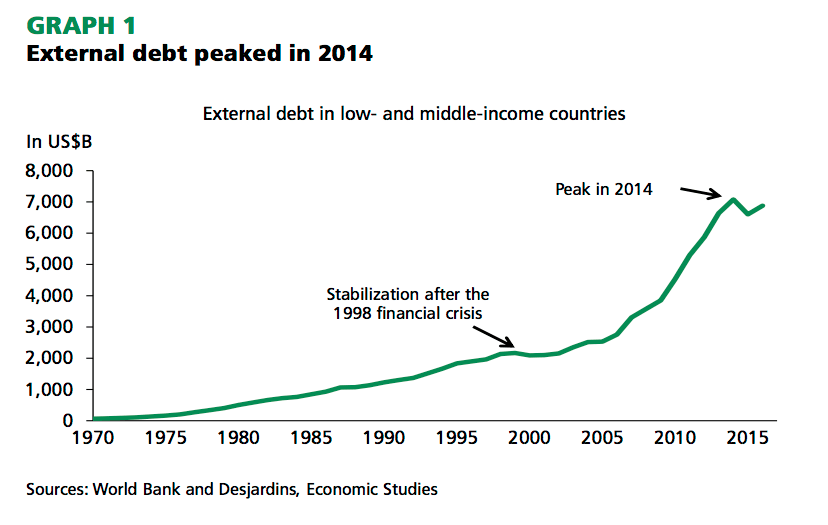Hello from a surprisingly-sunny London afternoon!
I’ve just returned from a weekend trip to Copenhagen and have been catching up on lectures and readings. This term I’ve planned some (student-budget friendly) weekend trips to Europe, so the few days spent in London are major catchup days.
This term I’m taking two new classes:
- Government Policy Analysis – a quantitative course analyzing issues regarding the role of governments, economic effects of government interventions, raising government revenue, and public service delivery
- International Institutions and Late Development – focused on international organizations and global governance, Public/Private Sovereign Debt, and the Int’l Trade Regime
In this blog, I’ll discuss the problem of international debt then end with highlights from my trip to Paris and conference at the Cumberland Lodge in Windsor Park.
Debt Overhang and Lack of SDRM
Levels of indebtedness have been increasing across the developing world, starting in the 1960s and taking off in the 1970s. Subsequent debt crises have led to an increased dependence on the IMF/WB, however these int’l institutions lack a sufficient debt restructuring mechanism. Addressing debt problems is critical for developing countries, because a large “debt overhang” hinders economic growth.

Debt overhang is the concept that a large debt burden hampers economic growth and prevents developing countries from escaping the poverty trap. Countries are unable to “grow out of their debt” because they are insolvent. This leads to a vicious cycle of low growth and high debt/GDP ratios.
There are two major arguments regarding this debt overhang.
- American economist Jeffrey Sachs argues that debt overhang perpetuates the poverty trap and that creditor-led debt reduction is a necessary precondition for economic growth. The “catalytic effect” of debt reduction increases investment and produces economic growth. His solution is a massive creditor-led reduction of debt.
- American economist William Easterly agrees that debt overhang is stifling, but argues that individual governments need to tighten their belts to address their debt problem. He notes the paradox of heavily indebted poor countries becoming heavily indebted after two decades of debt relief efforts. This indicates a failure of governments to shift long-run preferences and actions, instead responding to debt relief by running up new debts or running down assets. Easterly suggests the debt overhang is an issue of illiquidity rather than insolvency – and debtors need to change behavior to reduce their debt.
The majority of academics agree with Sachs.
There have been major attempts at the int’l institutional level to address debt overhang and mitigate costs of debt restructuring. From the Paris Club to HIPC1 and HIPC2, countries and int’l institutions have attempted to create an orderly mechanism to restructure multilateral debt. However, a Sovereign Debt Restructuring Mechanism (SDRM) – much like a “bankruptcy” agreement – has yet to emerge. HIPC2 is the reigning debt restructuring program, however it is far from comprehensive and doesn’t fully address the problem of debt overhang.
An IMF-run SDRM would acknowledge situations in which debts cannot be repaid and set procedures for dealing with these situations. Despite the perceived benefits from an orderly restructuring process of debts, all parties involved oppose its creation:
- Private creditors oppose the creation of an SDRM, arguing it is a “fast track to “default.”
- Creditor governments oppose the SDRM because they don’t want to subordinate their national legal systems and grant power to the IMF
- Debtor governments can’t advocate for the SDRM without signaling likelihood of default and thus raising the cost of borrowing.
- Debt NGOs are opposed because they don’t trust the IMF
As a result HIPC2 is the means by which multilateral debt structuring takes place – but its strict debt sustainability requirements/conditionalities prevent a comprehensive reduction of debt overhang. Thanks to a major commodity boom, the ease of finance following 2008 and China’s foray into the world of ODA, developing countries have been saved from their increased levels of indebtedness. Debt crises have been temporarily resolved not because of the current HIPC2 regime, but in spite of it.
When these unsustainable sources of debt relief retreat, the problem of developing countries’ indebtedness and lack of an SDRM will become prominent once again.
Paris, France
At the start of the new term, my friend Avery came to visit me for a week! We spent 5 days in London – visiting museums, watching Phantom of the Opera and Matilda in the West End and doing a major walking tour of London – before heading for a weekend in Paris.
In Paris, we visited a new art museum each day, visiting L’Orangerie, the Louvre, the Pablo Picasso Museum and the Musee d’Orsay. We also visited the churches of Notre Dame and Sainte-Chapelle, an ancient Roman stadium and visited Voltaire’s tomb in the Pantheon. A personal highlight was going to Les Invalides, seeing Napoleon’s tomb and visiting exhibitions on WWII and French imperial history.
Averaging about 13 miles of walking a day, Avery and I certainly deserved all the croissants, baguettes, and macarons we ate!

Cumberland Lodge
The Cumberland Weekend is an established LSE tradition where students and faculty spend a weekend in Windsor Park learning about environmental sustainability. During the weekend, we attended lectures about global warming and potential private/public solutions. We dined with LSE professors and had interesting conversations about the relationship between environment and development – a topic of which I previously had little knowledge.
On Sunday we attended a service at the Royal Chapel. The Queen frequents this Windsor chapel, however she was out on vacation that weekend – otherwise we students would have been able to interact with her!

It’s been quite a busy start to the term, but I couldn’t be more excited for my new courses and the weekend trips to come!
Cheers!


